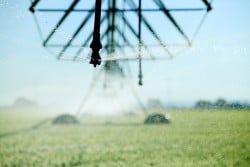Water issues are numerous and varied due to the impacts of climate change, aging infrastructure, a growing population, agricultural demands, and industrial production.
More people are taking ownership over the quality of the water in their own homes. Investing in a water treatment system provides added insurance that your family is getting the best water possible.
Water and Private Water Supplies
Using a private water supply, like well water, can no longer be thought of as an endless supply of clean water. Drought is impacting approximately 40% of the United States to varying degrees. The lack of snowpack and rainfalls that replenish groundwater supplies and the growing agricultural withdrawals for crop irrigation continue to squeeze groundwater supplies.
Animal farming can impact water quality, as fertilization practices introduce nitrates and bacteria into surface water like streams and rivers. These contaminants can wash into wells during heavy rain events or seep into the ground and infiltrate aquifers.
Water and Municipalities
Municipalities of all sizes face numerous challenges in the quest to supply clean water. In many large European and North American cities, the underground pipes that deliver water to homes are nearing the end of their useful life. Water main breaks are common and exacerbated by weather extremes that put pressure on the integrity of these pipes and create more fractures. Repair costs are enormous, and cities struggle to find the required money. Even with proper financing, it is nearly impossible to physically dig up and repair or replace the vast number of aging pipes in a timely fashion. In the meantime, people must hope they are not impacted by a water service interruption or a serious water contamination event.
Water and Small Communities
For small community water systems, the challenges are somewhat different. Loss of customer base as people continue to move toward large urban centers creates a financial burden. The EPA continues to expand the list of contaminants that must be monitored and removed from public water supplies (PWS), placing more pressure on already constrained resources. As a result, many struggle to comply with monitoring and reporting requirements. If a PWS cannot keep up with required water testing, how can they be certain of the quality of the water leaving the facility?
Byproducts
Another issue, for public water supplies of all sizes, is the matter of byproducts. Chlorine is absolutely necessary as a residual when water has to travel many miles before reaching our homes and offices. No one, however, wants to taste chlorine in their water, nor risk the exposure to the byproducts.
>> Next: Water Contamination
